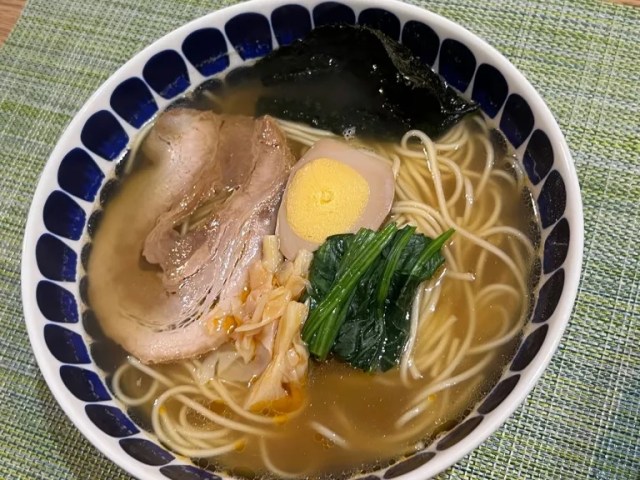
Taste-testing kyoseiten ramen noodles.
Walking around Japan, you may sometimes come across a station plaza or other event space with banners announcing that they’re having a kyoseiten. For example, here’s a photo of a kyoseiten that was going on last week in downtown Tokyo’s Shinjuku Station, the closest station to SoraNews24 headquarters.
▼ 矯正展 = kyoseiten
Kyoseiten directly translates to “correction exhibition.” However, the items on display, and being sold, aren’t refurbished products or factory seconds that have had their defects addressed. No, in the case of kyoseiten,“correction” is meant in the same sense as when talking about a correctional institute. In other words, all of the items are made by inmates as part of a prison work and education program.
The most common things you’ll find at a kyoseiten are leather and woodworking items such as wallets, shoulder bags, chairs, and chopsticks. Generally, the craftsmanship is beyond that of pure amateurs and students in shop classes, but not on the level of high-end professional artisans. The inmate-made products tend to be simple in design with only basic features, but not without a certain straightforward, rustic appeal.
At the kyoseiten we stumbled across in Shinjuku, tables and racks full of bags took up most of the floor space. As we looked around, though, we spotted something we don’t ever remember seeing at a kyoseiten: ramen noodles made by convicts.
The packs of dry ramen noodles were arranged in little piles, and selling for just 200 yen (US$1.40), with three servings per packet. According to the package, they contained chukamen, straight, thin noodles like the ones most commonly used for noodle soups in China, but also popular with Japanese-style ramen broth and toppings. In addition to standard ramen, the back of the package said that the noodles can be also be used for making hiyashi chuka (a cold noodle dish with minimal broth), tsukemen (in which the noodles are served by themselves and dipped into a separate bowl of broth before each bite), and even yakisoba (ramen noodles stir-fried with meat and vegetables). The packaging also told us that these noodles were made by inmates at the prison located in Konan Ward in Yokohama, Kanagawa Prefecture.
▼ 中華麺 = chukamen
To be honest, we weren’t sure what to expect in terms of quality with our prison-made noodles. On the one hand, dried ramen isn’t exactly gourmet, but it’s also a section of the noodle market where the competition is intense, since it includes instant and cup ramen. Competition, as they say, improves the breed, and with multiple major Japanese companies constantly researching and developing new recipes and techniques in an effort to make their ramen more satisfying than their rivals’, it wouldn’t be a shock if the budget and resources afforded to a prison work program limited it to churning out some less-than-stellar noodles, especially when they’re selling for just 200 yen a pack.
That price, it turns out, doesn’t quite tell the whole story, however. When we opened the package of prison noodles, we’d been expecting there to be some sort of powdered or liquid soup base with which to make the broth, since they’re usually included in dry ramen packs like this. Inside of our pack of prison noodles, though, were noodles, and nothing else.
In a way, this turned out to be a blessing in disguise. In our pantry we had a pack of Marutai Ramen, a popular and tasty brand of dry ramen noodles made by law-abiding private-sector citizens, and which come with enough broth base for multiple servings.
This let us prepare two bowls of ramen, one using the prison noodles, and one using the Marutai ones, but with the same broth for both. We also kept the toppings we added the same. The only difference was the noodles, and since Marutai’s are also thin and straight, we’d eliminated all possible differences except for the quality of the noodles themselves, which would let us see how the prisoner-made ones measured up.
The prison noodle packaging said to cook them for three to four minutes (we split the difference and cooked them for three and a half), and then to rinse them in cold water. Once we had both bowls of ramen prepared, we lined them up side by side. Can you tell which is which?
The prison-made noodles are…
…
…
…the ones in the bowl on the left.
Really, they looked just as delicious as the Marutai ones, so much so that we had to make a mental note of which was which, so that we wouldn’t forget and mix them up.
But the real thing we wanted to know is how these noodles tasted. We took a bit of the prison noodles, and…it was ramen. There was nothing strange, shocking, or off about them – just good, satisfying noodles.
That’s not to say that they were prefect, though. Like we said, the directions said to cook the noodles for three to four minutes, and we went with three and a half. After eating a bowl, though, we’re pretty sure they’d have been better if we’d stopped at three minutes flat. Three and a half minutes had left them on the overcooked and overly soft side, and they didn’t quite have that al dente sensation of firmness giving way to flexibility as you bite through, which is really what ramen connoisseurs like best in thin, straight noodles like these. That said, the prison noodles tasted just fine, and perfect texture really is something that’s hard to achieve when starting with dry ramen.
Turning to the Marutai noodles, we found their texture and flavor to be better than the prison noodles, but only slightly. So even though the prison noodles aren’t perfect, they’re still a perfectly viable option for a quick, hot meal.
Really, the only major drawback is that the prison noodles don’t come with any broth stock. Thinking back to what the packaging said, though, it recommends the noodles for use as ramen, hiyashi chuka, tsukemen, and yakisoba, all of which use different types of broth or sauce, so maybe that’s why there’re no such seasonings included, because they don’t know exactly what you’re going to use it for. And true enough, we haven’t decided how to use our remaining two servings of prison noodles either, but we have a hunch that they won’t let us down.
Photos © SoraNews24
● Want to hear about SoraNews24’s latest articles as soon as they’re published? Follow us on Facebook and Twitter!
[ Read in Japanese ]

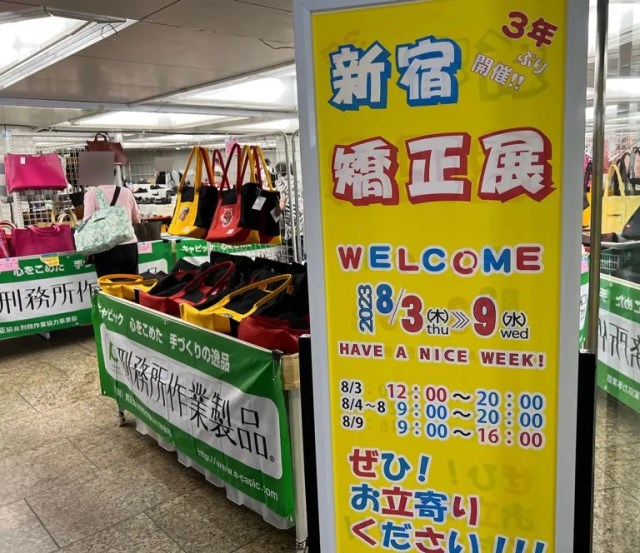
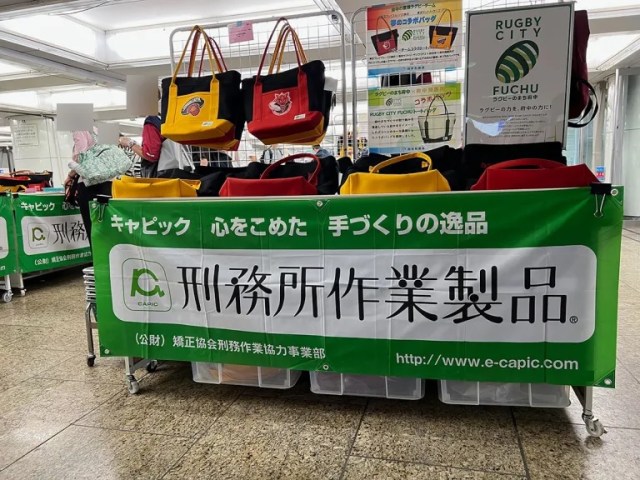
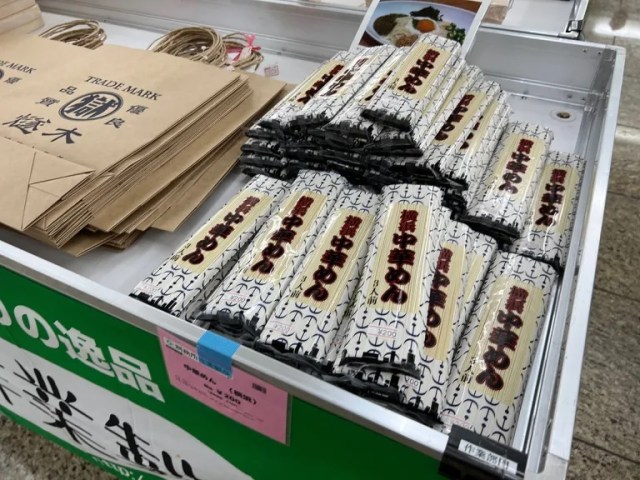

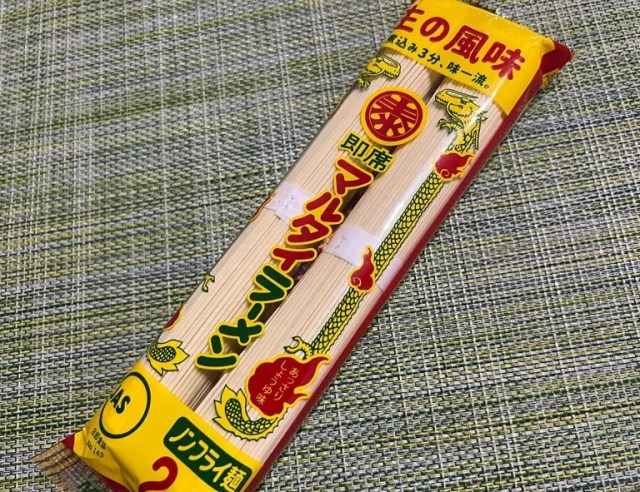
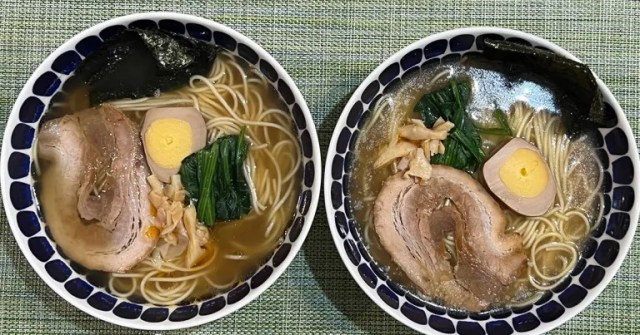
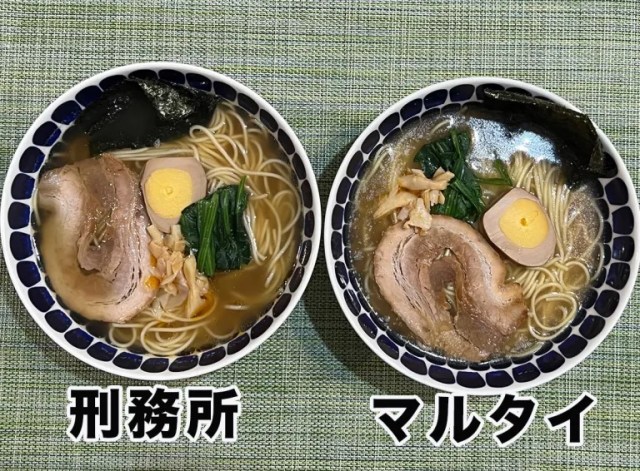
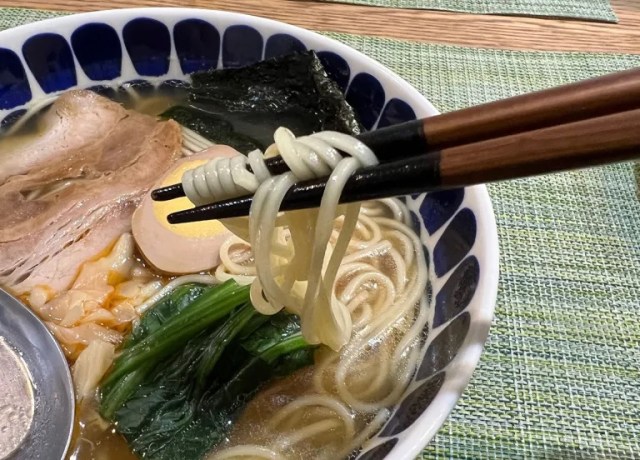
 Akihabara pop-up shop sells goods made by Japanese prison inmates
Akihabara pop-up shop sells goods made by Japanese prison inmates Japanese prison mascot appears in children’s colouring book made by prison inmates
Japanese prison mascot appears in children’s colouring book made by prison inmates Clash of the instant ramen! Taste-testing seven instant noodles on a flavor trip across Kyushu
Clash of the instant ramen! Taste-testing seven instant noodles on a flavor trip across Kyushu New Noodles and Broth Only cup ramen – Saddest meal ever, or proof that less is more?【Taste test】
New Noodles and Broth Only cup ramen – Saddest meal ever, or proof that less is more?【Taste test】 Which noodles, other than Okinawa soba, pair best with Okinawa soba broth?【Taste Test】
Which noodles, other than Okinawa soba, pair best with Okinawa soba broth?【Taste Test】 Is China’s don’t-go-to-Japan warning affecting tourist crowds in Shibuya’s Don Quijote?
Is China’s don’t-go-to-Japan warning affecting tourist crowds in Shibuya’s Don Quijote? Japan’s Shinkansen trains are getting a Super Mario makeover【Pics】
Japan’s Shinkansen trains are getting a Super Mario makeover【Pics】 Japan’s EF English Proficiency Index rank drops for 11th straight year, hits lowest ever
Japan’s EF English Proficiency Index rank drops for 11th straight year, hits lowest ever Japan considering raising international traveler departure tax even more than previously reported
Japan considering raising international traveler departure tax even more than previously reported Popular Japanese ramen restaurant Ichiran’s lucky bags are great value for money
Popular Japanese ramen restaurant Ichiran’s lucky bags are great value for money You can now buy a Japanese train station clock in Japan
You can now buy a Japanese train station clock in Japan Nintendo’s Kirby now delivering orders at Kura Sushi restaurants, but not in Japan
Nintendo’s Kirby now delivering orders at Kura Sushi restaurants, but not in Japan Real-world Nausicaa Ghibli anime glider completes its final flight in Japan【Video】
Real-world Nausicaa Ghibli anime glider completes its final flight in Japan【Video】 The 10 best day trips from downtown Tokyo【Survey】
The 10 best day trips from downtown Tokyo【Survey】 One Piece devil fruit ice cream coming back to Baskin-Robbins Japan
One Piece devil fruit ice cream coming back to Baskin-Robbins Japan Japan’s human washing machines will go on sale to general public, demos to be held in Tokyo
Japan’s human washing machines will go on sale to general public, demos to be held in Tokyo Japanese train company is letting fans buy its actual ticket gates for their homes
Japanese train company is letting fans buy its actual ticket gates for their homes Yoshinoya adds first-ever chain-wide ramen with new beef and pork-broth noodle hot pot meals
Yoshinoya adds first-ever chain-wide ramen with new beef and pork-broth noodle hot pot meals Is China’s don’t-go-to-Japan warning affecting tourist crowd sizes in Nara?
Is China’s don’t-go-to-Japan warning affecting tourist crowd sizes in Nara? Studio Ghibli stamps lift your spirits with motivational phrases from Totoro
Studio Ghibli stamps lift your spirits with motivational phrases from Totoro New fish discovered and named “Vanderhorstia supersaiyan” for obvious reasons
New fish discovered and named “Vanderhorstia supersaiyan” for obvious reasons Japanese town suing resident for being a jerk
Japanese town suing resident for being a jerk Starbucks Japan unveils new Christmas goods and a rhinestone tumbler that costs 19,500 yen
Starbucks Japan unveils new Christmas goods and a rhinestone tumbler that costs 19,500 yen Brand-new Pokémon park opens in Japan with larger-than-life-size Lapras【Photos】
Brand-new Pokémon park opens in Japan with larger-than-life-size Lapras【Photos】 Unique inclined elevator in Japan leads to a town that inspired Studio Ghibli’s Spirited Away
Unique inclined elevator in Japan leads to a town that inspired Studio Ghibli’s Spirited Away Is China’s don’t-go-to-Japan warning affecting tourist crowds in Tokyo’s Asakusa neighborhood?
Is China’s don’t-go-to-Japan warning affecting tourist crowds in Tokyo’s Asakusa neighborhood? Naturally brown-haired Osaka student sues government for forcing her to dye her hair black
Naturally brown-haired Osaka student sues government for forcing her to dye her hair black Tokyo hotel lets you make your stay a Sanrio one with special My Melody and Kuromi rooms【Pics】
Tokyo hotel lets you make your stay a Sanrio one with special My Melody and Kuromi rooms【Pics】 Survey asks foreign tourists what bothered them in Japan, more than half gave same answer
Survey asks foreign tourists what bothered them in Japan, more than half gave same answer Japan’s deadliest food claims more victims, but why do people keep eating it for New Year’s?
Japan’s deadliest food claims more victims, but why do people keep eating it for New Year’s? We deeply regret going into this tunnel on our walk in the mountains of Japan
We deeply regret going into this tunnel on our walk in the mountains of Japan Studio Ghibli releases Kodama forest spirits from Princess Mononoke to light up your home
Studio Ghibli releases Kodama forest spirits from Princess Mononoke to light up your home Major Japanese hotel chain says reservations via overseas booking sites may not be valid
Major Japanese hotel chain says reservations via overseas booking sites may not be valid Put sesame oil in your coffee? Japanese maker says it’s the best way to start your day【Taste test】
Put sesame oil in your coffee? Japanese maker says it’s the best way to start your day【Taste test】 The top 10 annoying foreign tourist behaviors on trains, as chosen by Japanese people【Survey】
The top 10 annoying foreign tourist behaviors on trains, as chosen by Japanese people【Survey】 No more using real katana for tourism activities, Japan’s National Police Agency says
No more using real katana for tourism activities, Japan’s National Police Agency says J-pop mega star Ado reveals she’s been living in the U.S., may not understand language acquisition
J-pop mega star Ado reveals she’s been living in the U.S., may not understand language acquisition Japan’s Ramen Blanket wants to provide you with sweet noodle dreams【Photos】
Japan’s Ramen Blanket wants to provide you with sweet noodle dreams【Photos】 Instant vs. Restaurant Ramen Project: Ippudo spicy miso tonkotsu battle【Taste test】
Instant vs. Restaurant Ramen Project: Ippudo spicy miso tonkotsu battle【Taste test】 “THIS is Pork!” 7-Eleven’s pre-made chashu pork is here to elevate your instant ramen【Taste test】
“THIS is Pork!” 7-Eleven’s pre-made chashu pork is here to elevate your instant ramen【Taste test】 What does vegan ramen taste like? We try Veggie Brown Rice Ramen
What does vegan ramen taste like? We try Veggie Brown Rice Ramen Matcha green tea instant Cup Noodle ramen is here, with a totally unexpected taste【Taste test】
Matcha green tea instant Cup Noodle ramen is here, with a totally unexpected taste【Taste test】 Tokyo’s new frozen ramen vending machines are brain-breakingly amazing【Taste test】
Tokyo’s new frozen ramen vending machines are brain-breakingly amazing【Taste test】 You can now get shaved ice ramen in Japan, and it’s painfully delicious【Taste test】
You can now get shaved ice ramen in Japan, and it’s painfully delicious【Taste test】 Taste-testing Japan’s three biggest convenience stores store-brand cup ramen【Taste test】
Taste-testing Japan’s three biggest convenience stores store-brand cup ramen【Taste test】 Is Japan’s new pain-in-the-butt instant ramen also a joy in the stomach?【Taste test】
Is Japan’s new pain-in-the-butt instant ramen also a joy in the stomach?【Taste test】 We try Nissin’s newest world flavors-inspired cup noodle: Chili Con Carne【Taste Test】
We try Nissin’s newest world flavors-inspired cup noodle: Chili Con Carne【Taste Test】 Introducing Nomen: Ramen without the noodles【Taste test】
Introducing Nomen: Ramen without the noodles【Taste test】 We try the “longest ramen in history”【Taste test】
We try the “longest ramen in history”【Taste test】 Takeout ramen broth: A new Tokyo winter noodle trend that’s worth the hype? 【Taste Test】
Takeout ramen broth: A new Tokyo winter noodle trend that’s worth the hype? 【Taste Test】 Is ramen without the “men” a Tokyo dining paradox worth experiencing?【Taste test】
Is ramen without the “men” a Tokyo dining paradox worth experiencing?【Taste test】 Using tempura as a ramen topping – Blasphemy, or a beautiful idea?【Taste test】
Using tempura as a ramen topping – Blasphemy, or a beautiful idea?【Taste test】 Ichiran Ramen’s delicious new product: Fried tonkotsu noodles!
Ichiran Ramen’s delicious new product: Fried tonkotsu noodles!
Leave a Reply